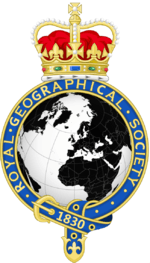Roderick Murchison
Sir Roderick Impey Murchison, 1st Baronet, KCB, FRS, HonFRSE, FLS, MRIA (22 February 1792[1] – 22 October 1871) was a Scottish geologist who first described and investigated the Silurian system.[2]
Sir Roderick Murchison | |
|---|---|
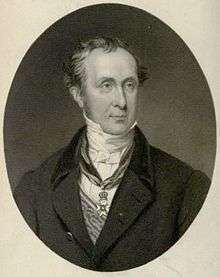 Sir Roderick Murchison | |
| Born | 22 February 1792 Tarradale House, Muir of Ord, Ross-shire, UK |
| Died | 22 October 1871 (aged 79) London, UK |
| Nationality | Scottish |
| Known for | Silurian system Devonian system Permian system |
| Spouse(s) | Charlotte Hugonin |
| Awards | Copley Medal (1849) Makdougall Brisbane Prize (1859) Wollaston Medal (1864) Founder's Medal (1871) |
| Scientific career | |
| Fields | Geology |
| Signature | |
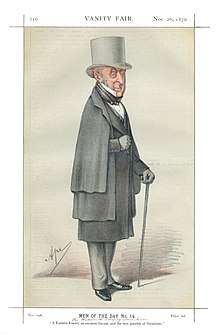
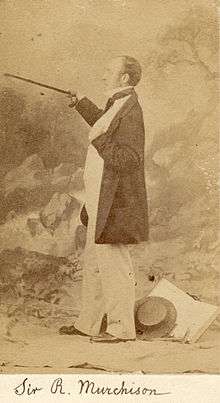
Early life and work
Murchison was born at Tarradale House, Muir of Ord, Ross-shire, the son of Kenneth Murchison. His wealthy father died in 1796, when Roderick was four years old, and he was sent to Durham School three years later,[3] and then the Royal Military College, Great Marlow to be trained for the army. In 1808 he landed with Wellesley in Portugal, and was present at the actions of Roliça and Vimeiro in the Peninsular War as an ensign in the 36th Regt of Foot. Subsequently under Sir John Moore, he took part in the retreat to Corunna and the final battle there.
After eight years of service Murchison left the army, and married Charlotte Hugonin (1788–1869), the only daughter of General Hugonin, of Nursted House, Hampshire. Murchison and his wife spent two years in mainland Europe, particularly in Italy. They then settled in Barnard Castle, County Durham, England in 1818 where Murchison made the acquaintance of Sir Humphry Davy. Davy urged Murchison to turn his energy to science, after hearing that he wasted his time riding to hounds and shooting. With encouragement from his wife Charlotte,[4] Murchison became fascinated by the young science of geology and joined the Geological Society of London, soon becoming one of its most active members. His colleagues there included Adam Sedgwick, William Conybeare, William Buckland, William Fitton, Charles Lyell and Charles Darwin.
Exploring with his wife, Murchison studied the geology of the south of England, devoting special attention to the rocks of the north-west of Sussex and the adjoining parts of Hampshire and Surrey, on which, aided by Fitton, he wrote his first scientific paper, read to the Geological Society of London in 1825. Turning his attention to Continental geology, he and Lyell explored the volcanic region of Auvergne, parts of southern France, northern Italy, Tyrol and Switzerland. A little later, with Sedgwick as his companion, Murchison attacked the difficult problem of the geological structure of the Alps. Their joint paper giving the results of their study is a classic in the literature of Alpine geology.
Murchison was an opponent of Charles Darwin's theory of evolution. He opposed the transmutation of species and supported successive creation.[5][6]
Silurian system
In 1831 he went to the England–Wales border, to attempt to discover whether the greywacke rocks underlying the Old Red Sandstone could be grouped into a definite order of succession. The result was the establishment of the Silurian system under which were grouped, for the first time, a remarkable series of formations, each replete with distinctive organic remains other than and very different from those of the other rocks of England. These researches, together with descriptions of the coalfields and overlying formations in South Wales and the English border counties, were embodied in The Silurian System (1839).
The establishment of the Silurian system was followed by that of the Devonian system, an investigation in which Murchison assisted, both in the south-west of England and in the Rhineland. Soon afterwards Murchison projected an important geological campaign in Russia with the view of extending to that part of the Continent the classification he had succeeded in elaborating for the older rocks of western Europe. He was accompanied by Édouard de Verneuil (1805–1873) and Count Alexander von Keyserling (1815–1891), in conjunction with whom he produced a work on Russia and the Ural Mountains. The publication of this monograph in 1845 completes the first and most active half of Murchison's scientific career. He was elected a Foreign Honorary Member of the American Academy of Arts and Sciences in 1840.[7]
In 1846 he was knighted, and in the same year he presided over the meeting of the British Association at Southampton. During the later years of his life a large part of his time was devoted to the affairs of the Royal Geographical Society, of which he was in 1830 one of the founders, and he was president 1843–1845, 1851–1853, 1856–1859 and 1862–1871. He served on the Royal Commission on the British Museum (1847–49).[8]
Scotland
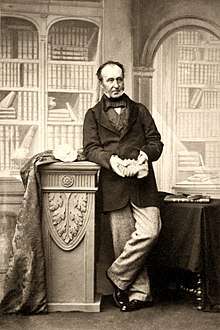
The chief geological investigation of the last decade of his life was devoted to the Highlands of Scotland, where he wrongly believed he had succeeded in showing that the vast masses of crystalline schists, previously supposed to be part of what used to be termed the Primitive formations, were really not older than the Silurian period, for that underneath them lay beds of limestone and quartzite containing Lower Silurian (Cambrian) fossils. James Nicol recognised the fallacy in the Murchison's extant theory and propounded his own ideas, in the 1880s these were superseded by the correct theory of Charles Lapworth, which was corroborated by Benjamin Peach and John Horne. Their subsequent research showed that the infraposition of the fossiliferous rocks is not their original place, but had been brought about by a gigantic system of dislocations, whereby successive masses of the oldest gneisses, have been exhumed from below and thrust over the younger formations.
In 1855 Murchison was appointed director-general of the British Geological Survey and director of the Royal School of Mines and the Museum of Practical Geology in Jermyn Street, London, in succession to Sir Henry De la Beche, who had been the first to hold these offices. Official routine now occupied much of his time, but he found opportunity for the Highland researches just alluded to, and also for preparing successive editions of his work Siluria (1854, ed. 5, 1872), which was meant to present the main features of the original Silurian System together with a digest of subsequent discoveries, particularly of those that showed the extension of the Silurian classification into other countries.
Later life
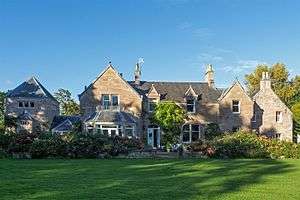
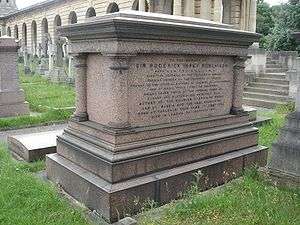
In 1845, whilst visiting Carclew in Cornwall, he met several Cornish miners who were going to Australia. Believing that there might be gold there he asked them to send back likely samples. They did this and thus Murchison knew of the existence of gold in Australia before Edward Hargraves' discovery.[9] In 1857, Murchison was elected a member of the American Antiquarian Society.[10]
In 1863, he was made a KCB, and three years later was created a baronet. The learned societies of his own country bestowed their highest rewards upon him: the Royal Society gave him the Copley Medal, the Geological Society its Wollaston medal, and the Royal Society of Edinburgh its Brisbane Medal. There was hardly a foreign scientific society of note without his name among its honorary members. The French Academy of Sciences awarded him the prix Cuvier, and elected him one of its eight foreign members in succession to Michael Faraday. In 1855, he was elected a foreign member of the Royal Swedish Academy of Sciences and in 1871 awarded the Founder's Gold Medal of the Royal Geological Society.[11]
One of the closing public acts of Murchison's life was the founding of a chair of geology and mineralogy at the University of Edinburgh. Under his will there was established the Murchison Medal and a geological fund (The Murchison Fund) to be awarded annually by the council of the Geological Society in London.
Murchison died in 1871, and is buried in Brompton Cemetery, London, near the north end of the arcade on the west side of the central path.
Legacy
The crater Murchison on the Moon and at least fifteen geographical locations on Earth are named after him.
These include: the Murchison Range, part of the Stauning Alps, and the Murchison Sound in Greenland;[12] Mount Murchison in Banff National Park, Canada; Mount Murchison in the Mountaineer Range, Antarctica; Mount Murchison, just west of Squamish, British Columbia, Canada; tiny Murchison Island in Haida Gwaii in the same province; the Murchison Falls in Uganda; the Murchison River in Western Australia.[13] Murchison has two other rivers named after him in Western Australia: the Roderick River and the Impey River, both tributaries of the Murchison. The town of Murchison in the Tasman Region of New Zealand's South Island was also named after him. Murchison Road is one of the streets in east London, and there is a Murchison Avenue in Old Bexley, south East London. Scarborough in North Yorkshire has a Murchison Street.
Memorials
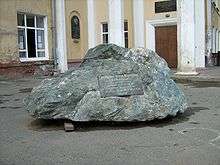
A memorial tablet of Murchison was installed on 3 November 2005, in front of School #9 in Perm in Russia.[14] It consists of a stone base, irregular in form, about two metres long, and bearing a dark stone plate with the Russian inscription:
To Roderick Impey Murchison, Scottish geologist, explorer of Perm Krai, who gave to the last period of the Paleozoic era the name of Permian.
The decision to perpetuate the explorer's name was accepted by the school administration and pupils in connection with a discussion to establish in Perm a pillar or an arch devoted to Roderick Murchison.
In 2009, the Ural-Scottish Society erected a memorial to Murchison on the banks of the Chusovaya River.[15]
There is a commemorative 'blue plaque' on his residence in Barnard Castle (County Durham) at 21 Galgate.
Bibliography
- Outline of the Geology of the Neighbourhood of Cheltenham. H. Davies. 1834.CS1 maint: ref=harv (link)
- The Silurian System. London: John Murray. 1839.CS1 maint: ref=harv (link)
- On the Geological Structure of the Central and Southern Regions of Russia in Europe, and of the Ural Mountains. Print. by R. and J.E. Taylor. 1842.CS1 maint: ref=harv (link)
- Geology of Russia in Europe and the Ural Mountains. Vol. 1: Parts 1 & 2 - Geology. 1845. with Edouard de Verneuil and Count Alexander Keyserling
- Géologie de la Russie d'Europe et des montagnes de l'Oural [Geology of Russia in Europe and the Ural Mountains] (in French). Vol. 2: Part 3 - Palaentology. Paris: P. Bertrand. 1845.
References
Notes
- Amodeo 2005.
- Geikie 1911, pp. 31-32.
- Bonney, T. G.; Stafford, The Revd Robert A. "Murchison, Sir Roderick Impey, baronet (1792–1871)". Oxford Dictionary of National Biography (online ed.). Oxford University Press. doi:10.1093/ref:odnb/19555.
In 1799 Roderick was placed at the grammar school, Durham, where he led in mischief more often than in his class.
(Subscription or UK public library membership required.) - Kölbl-Ebert, Martina (January 1997). "Charlotte Murchison (Née Hugonin) 1788-1869". Earth Sciences History. 16 (1): 39–43. doi:10.17704/eshi.16.1.97014235w8u4k414. ISSN 0736-623X.
- Geikie 1875, pp. 321-322.
- Branch 2016.
- "Book of Members, 1780–2010: Chapter M" (PDF). American Academy of Arts and Sciences. Retrieved 15 September 2016.
- Fagan 1880, p. 257.
- Bonython, John Langdon (1933–34), "Address of the President", Journal of the Royal Institution of Cornwall, XXIV, Parts 1 and 2, p. 5
- "Members Directory". American Antiquarian Society.
- "List of Past Gold Medal Winners" (PDF). Royal Geographical Society. Archived from the original (PDF) on 27 September 2011. Retrieved 24 August 2015.
- "Catalogue of place names in northern East Greenland" (PDF). Geological Survey of Denmark. Archived from the original (PDF) on 30 December 2016. Retrieved 30 December 2016.
- BCGNIS listing "Mount Murchison" at Archive.today (archived 2007-08-15)
- Chernov, Nikita (21 October 2015). "Школьники установили памятный знак геологу, открывшему Пермский период Палеозоя" [School pupils established a memorial to the geologist who discovered the Permian period of Paleozoic Era] (in Russian). Archived from the original on 11 March 2007. Retrieved 27 March 2017.
- "A memorial to Sir Roderick Impey Murchison, the Scottish geologist who established the Permian archaeological period of the Mesozoic Era, has been unveiled on the bank of the Chusovaya River in the Ural Mountains". Daily Telegraph. 24 February 2009. Retrieved 27 March 2010.
- IPNI. Murch.
Sources
- Amodeo, Christian (June 2005). "Sir Roderick Impey Murchison: Pioneering Scottish geologist Roderick Murchison was instrumental in the identification and naming of several geological time periods". Geographical.CS1 maint: ref=harv (link)
- Fagan, Louis (1880). The Life of Sir Anthony Panizzi, K. C. B.: Late Principal Librarian of the British Museum, Senator of Italy, &c., &c. Volume 1. Boston: Houghton.CS1 maint: ref=harv (link)
- Branch, Glenn (2016). "Misquoting Murchison". National Center for Science Education.CS1 maint: ref=harv (link)
- Geikie, Archibald (1875). Life of Sir Roderick I. Murchison: Based on His Journals and Letters. 2. London: John Murray.CS1 maint: ref=harv (link)
- Geikie, Archibald (1911). . In Chisholm, Hugh (ed.). Encyclopædia Britannica. 19 (11th ed.). Cambridge University Press. pp. 31–32.CS1 maint: ref=harv (link)
Further reading
- Geikie, Archibald (1875). Life of Sir Roderick I. Murchison. I. London: John Murray. Retrieved 26 February 2019 – via Internet Archive.
- Geikie, Archibald (1875). Life of Sir Roderick I. Murchison. II. London: John Murray. Retrieved 26 February 2019 – via Internet Archive.
- Hestmark, Geir (2008). "A primitive country of rocks and people" – Roderick I Murchison's Silurian Campaign in Norway 1844". Norwegian Journal of Geology. 88: 117–141.CS1 maint: ref=harv (link)
- Morton, John L. (2004). King of Siluria — How Roderick Murchison Changed the Face of Geology. Brocken Spectre. ISBN 0-9546829-0-4.
- Rudwick, Martin J. S. (1985). The Great Devonian Controversy: The Shaping of Scientific Knowledge among Gentlemanly Specialists. University of Chicago Press. — the rise of Murchison to power
- Secord, James A. (1986). Controversy in Victorian Geology: The Cambrian-Silurian Dispute. Princeton University Press. — documents the battle between Murchison and Adam Sedgwick
- Collie, M.; Diener, J., eds. (2004), Murchison's Wanderings in Russia: His Geological Exploration of Russia in Europe and the Ural Mountains, 1840-1841, British Geological Survey Occasional Publication No. 2., Buckinghamshire: Halstan & Co., p. 474
- Murchison, Arthur (2014). War Before Science: Sir Robert Impey Murchison's Youth, Army Service and Military Associates During the Napoleonic Wars. Academica Press. ISBN 978-1-936320-74-5.
- Stafford, Robert A. (1989). Scientist of Empire: Sir Roderick Murchison, Scientific Exploration and Victorian Imperialism. Cambridge University Press. - documents Murchison's role in promoting the symbiotic relationship between the natural sciences and British imperialism
- "Sir Roderick Murchison (Obituary Notice, Monday, October 23, 1871)". Eminent Persons: Biographies reprinted from The Times. I (1870-1875). London: Macmillan and Co. 1892. pp. 63–75. hdl:2027/uc2.ark:/13960/t6n011x45.
External links
| Wikimedia Commons has media related to Roderick Murchison. |
